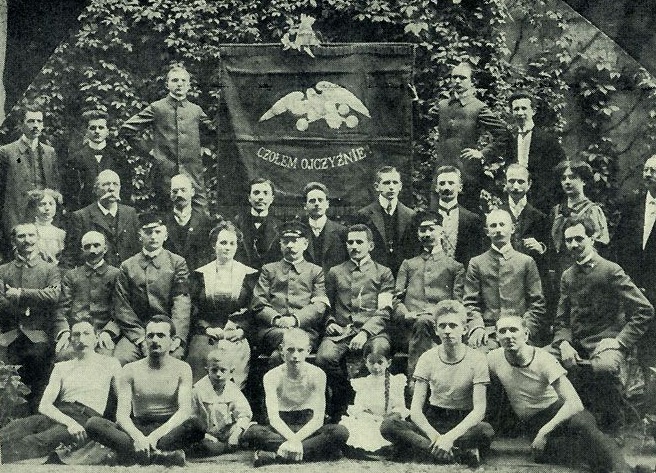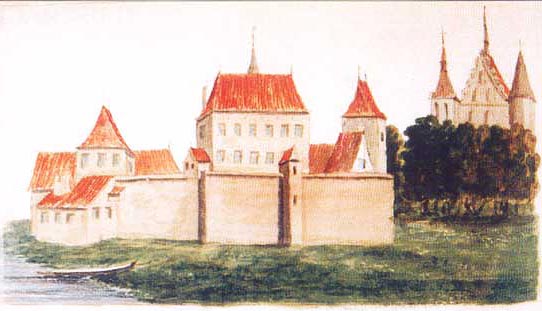|
Tadeusz Pełczyński
Tadeusz Walenty Pełczyński (codenames: ''Grzegorz'', ''Adam'', ''Wolf'', ''Robak''; Warsaw, 14 February 1892 – 3 January 1985, London) was a Polish Army major general (''generał brygady''), intelligence officer and chief of the General Staff's Section II (the military intelligence section). During World War II, he became chief of staff of the Home Army (''ZWZ'', ''Armia Krajowa''; July 1941 – October 1944) and its deputy commander (July 1943 – October 1944). Early life and education Tadeusz Pełczyński was the son of Ksawery Pełczyński, a Sanniki sugar-mill technician, and Maria, ''née'' Liczbińska, a teacher, and was a great-grandson of Michał Pełczyński, a general in the Army of Congress Poland. Pełczyński began school in Łęczyca. In 1905 he participated in a school strike connected with Polish efforts to win independence from the Russian Empire. He continued his schooling in Warsaw at the Gen. Paweł Chrzanowski '' Gymnasium''. In 1911 he began medica ... [...More Info...] [...Related Items...] OR: [Wikipedia] [Google] [Baidu] |
Tadeusz Pełczyński
Tadeusz Walenty Pełczyński (codenames: ''Grzegorz'', ''Adam'', ''Wolf'', ''Robak''; Warsaw, 14 February 1892 – 3 January 1985, London) was a Polish Army major general (''generał brygady''), intelligence officer and chief of the General Staff's Section II (the military intelligence section). During World War II, he became chief of staff of the Home Army (''ZWZ'', ''Armia Krajowa''; July 1941 – October 1944) and its deputy commander (July 1943 – October 1944). Early life and education Tadeusz Pełczyński was the son of Ksawery Pełczyński, a Sanniki sugar-mill technician, and Maria, ''née'' Liczbińska, a teacher, and was a great-grandson of Michał Pełczyński, a general in the Army of Congress Poland. Pełczyński began school in Łęczyca. In 1905 he participated in a school strike connected with Polish efforts to win independence from the Russian Empire. He continued his schooling in Warsaw at the Gen. Paweł Chrzanowski '' Gymnasium''. In 1911 he began medica ... [...More Info...] [...Related Items...] OR: [Wikipedia] [Google] [Baidu] |
Sokół
Sokół (, English: Falcon), or in full the Polskie Towarzystwo Gimnastyczne "Sokół" ( en, "Falcon" Polish Gymnastic Society), is the Poland, Polish offshoot of the Czech lands, Czech Sokol movement, and the oldest youth movement organization of Poland. Created in Lviv, Lwów in 1867, by the end of World War I the movement had its units – ''gniazda'' ("Nests") – in all parts of Poland, as well as among the Polish diaspora, Polish communities abroad. The group's goal was to develop fitness, both physically and mentally, with a motto ''mens sana in corpore sano'' ("a fit spirit in a fit body"). History Sokół was formed February 7, 1867 in Lwów, then a capital of Austria-Hungary, Austro-Hungarian Galicia (Central Europe), Galicia. The basic aims of the society were promotion of gymnastics and national revival in all parts of partitions of Poland, partitioned Poland. In 1885 the first chairman, Józef Millert managed to convince the German Empire, German authoriti ... [...More Info...] [...Related Items...] OR: [Wikipedia] [Google] [Baidu] |
Beniaminów
Beniaminów is a village in Poland. It has approximately 190 inhabitants (1998) and is located in the Masovian Voivodship, east of Warsaw, between Legionowo and Nieporęt. Within the village are remnants of a 19th-century fort. In 1917, after the Oath Crisis, members of the Polish Legions who had refused to swear an oath of loyalty to the German Kaiser were interned there. During World War II, between 1941 and 1944, the German Wehrmacht ran a prisoner-of-war camp A prisoner-of-war camp (often abbreviated as POW camp) is a site for the containment of enemy fighters captured by a belligerent power in time of war. There are significant differences among POW camps, internment camps, and military prisons. P ... (Stalag 333) there for Soviet soldiers. More than 30,000 of them died from harsh treatment and malnutrition. Villages in Legionowo County {{Legionowo-geo-stub ... [...More Info...] [...Related Items...] OR: [Wikipedia] [Google] [Baidu] |
Oath Crisis
The Oath crisis ( pl, Kryzys przysięgowy) was a World War I political conflict between the Imperial German Army command and the Józef Piłsudski-led Polish Legions. Initially supporting the Central Powers against Imperial Russia, Piłsudski hoped for the defeat of one of the partitioning powers—Russia—with the help of the other two partitioning states, Austria-Hungary and Germany. However, after the Russian defeat in 1917 it became clear that the Central Powers were in no position to guarantee the independence of Poland. Despite the Act of November 5th of 1916 and the creation of Kingdom of Poland, it was apparent that the newly created state would be little more than a puppet buffer-state for Germany, a part of its Mitteleuropa plan. At this point, Piłsudski decided to switch allegiances to gain the support of the Entente, particularly France and the United Kingdom, for the cause of Polish independence. A good pretext appeared in July 1917, when the Central Powers d ... [...More Info...] [...Related Items...] OR: [Wikipedia] [Google] [Baidu] |
Company (military)
A company is a military unit, typically consisting of 80–250 soldiers and usually commanded by a major or a captain. Most companies are formed of three to seven platoons, although the exact number may vary by country, unit type, and structure. Usually several companies are grouped as a battalion or regiment, the latter of which is sometimes formed by several battalions. Occasionally, ''independent'' or ''separate'' companies are organized for special purposes, such as the 1st Air Naval Gunfire Liaison Company or the 3rd Force Reconnaissance Company. These companies are not organic to a battalion or regiment, but rather report directly to a higher level organization such as a Marine Expeditionary Force headquarters (i.e., a corps-level command). Historical background The modern military company became popularized during the reorganization of the Swedish Army in 1631 under King Gustav II Adolph. For administrative purposes, the infantry was divided into companies consist ... [...More Info...] [...Related Items...] OR: [Wikipedia] [Google] [Baidu] |
Platoon
A platoon is a military unit typically composed of two or more squads, sections, or patrols. Platoon organization varies depending on the country and the branch, but a platoon can be composed of 50 people, although specific platoons may range from 10 to 100 people. A platoon is typically the smallest military unit led by a commissioned officer. The platoon leader is usually a junior officer—a second or first lieutenant or an equivalent rank. The officer is usually assisted by a platoon sergeant. Rifle platoons normally consist of a small platoon headquarters and three or four sections (Commonwealth) or squads (United States). In some armies, platoon is used throughout the branches of the army. In a few armies, such as the French Army, a platoon is specifically a cavalry unit, and the infantry use "section" as the equivalent unit. A unit consisting of several platoons is called a company or a battery. Etymology According to Merriam-Webster, "The term was first used in th ... [...More Info...] [...Related Items...] OR: [Wikipedia] [Google] [Baidu] |
Polish Legions In World War I
The Polish Legions ( pl, Legiony Polskie) was a name of the Polish military force (the first active Polish army in generations) established in August 1914 in Galicia soon after World War I erupted between the opposing alliances of the Triple Entente on one side (comprising the British Empire, the French Republic and the Russian Empire); and the Central Powers on the other side, comprising the German Empire and Austria-Hungary. The Legions became "a founding myth for the creation of modern Poland" in spite of their considerably short existence; they were replaced by the Polish Auxiliary Corps ( pl, Polski Korpus Posiłkowy) formation on 20 September 1916, merged with Polish II Corps in Russia on 19 February 1918 for the Battle of Rarańcza against Austria-Hungary, and disbanded following the military defeat at the Battle of Kaniów in May 1918,WIEM Encyklopedia (2015)Polski Korpus Posiłkowyat PortalWiedzy.onet.pl against imperial Germany. General Haller escaped to France to form ... [...More Info...] [...Related Items...] OR: [Wikipedia] [Google] [Baidu] |
Prisoner-of-war Camp
A prisoner-of-war camp (often abbreviated as POW camp) is a site for the containment of enemy fighters captured by a belligerent power in time of war. There are significant differences among POW camps, internment camps, and military prisons. Purpose-built prisoner-of-war camps appeared at Norman Cross in England in 1797 during the French Revolutionary Wars and HM Prison Dartmoor, constructed during the Napoleonic Wars, and they have been in use in all the main conflicts of the last 200 years. The main camps are used for marines, sailors, soldiers, and more recently, airmen of an enemy power who have been captured by a belligerent power during or immediately after an armed conflict. Civilians, such as Merchant navy, merchant mariners and war correspondents, have also been imprisoned in some conflicts. With the adoption of the Geneva Convention on Prisoners of War (1929), Geneva Convention on the Prisoners of War in 1929, later superseded by the Third Geneva Convention, prisoner-o ... [...More Info...] [...Related Items...] OR: [Wikipedia] [Google] [Baidu] |
Medic
A medic is a person involved in medicine such as a medical doctor, medical student, paramedic or an emergency medical responder. Among physicians in the UK, the term "medic" indicates someone who has followed a "medical" career path in postgraduate professional training accredited by a College of Physicians, such as cardiology or endocrinology, in contrast to a surgical branch of specialisation accredited by a College of Surgeons. Types "Medic" titled roles include: * Emergency physician, a medical doctor (M.D. or D.O.) who has specialized postgraduate training in emergency diagnostics and treatment * Combat Medical Technician, a soldier with a specialist military trade within the Royal Army Medical Corps of the British Army * Combat medic (in various nations) * Corpsman, a sailor who is trained for providing first aid to members of the US Armed Forces, combat casualty care/trauma care on the battlefield (This name is only used by the Navy and Marine Corps for the Hospital Corp ... [...More Info...] [...Related Items...] OR: [Wikipedia] [Google] [Baidu] |
Włocławek
Włocławek (Polish pronunciation: ; german: Leslau) is a city located in central Poland along the Vistula (Wisła) River and is bordered by the Gostynin-Włocławek Landscape Park. As of December 2021, the population of the city is 106,928. Located in the Kuyavian-Pomeranian Voivodeship, it was the capital of Włocławek Voivodeship until 1999. The city is located in the historical region of Kuyavia and is the region's third largest city after Bydgoszcz and Toruń. History Włocławek's history dates back to the late Bronze Age – early Iron Age (1300 BCE – 500 BCE). Archaeological excavations conducted on the current city site uncovered the remains of a settlement belonging to the Lusatian culture, as well as evidence of a settlement of early Pomeranian culture which had been established. Traces of additional settlements dating to the Roman period and the early Middle Ages have also been excavated in the area. Middle Ages Precise dating of the city's founding has proven ... [...More Info...] [...Related Items...] OR: [Wikipedia] [Google] [Baidu] |
Warsaw Uprising
The Warsaw Uprising ( pl, powstanie warszawskie; german: Warschauer Aufstand) was a major World War II operation by the Polish resistance movement in World War II, Polish underground resistance to liberate Warsaw from German occupation. It occurred in the summer of 1944, and it was led by the Polish resistance Home Army ( pl, Armia Krajowa). The uprising was timed to coincide with the retreat of the German forces from Poland ahead of the Soviet advance. While approaching the eastern suburbs of the city, the Red Army temporarily halted combat operations, enabling the Germans to regroup and defeat the Polish resistance and to Planned destruction of Warsaw, destroy the city in retaliation. The Uprising was fought for 63 days with little outside support. It was the single largest military effort taken by any European Resistance during World War II, resistance movement during World War II. The Uprising began on 1 August 1944 as part of a nationwide Operation Tempest, launched at the ... [...More Info...] [...Related Items...] OR: [Wikipedia] [Google] [Baidu] |



.jpg)